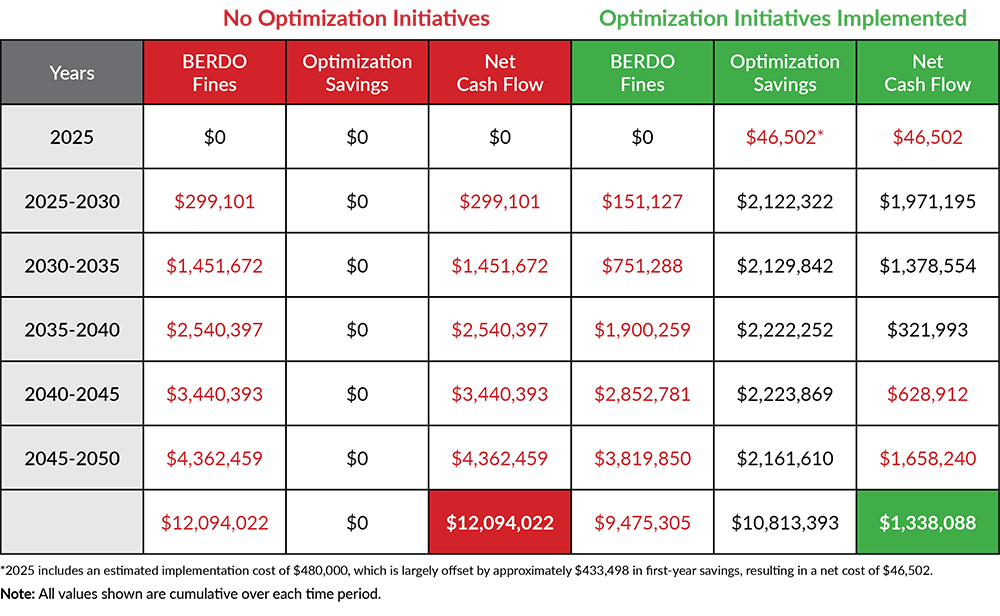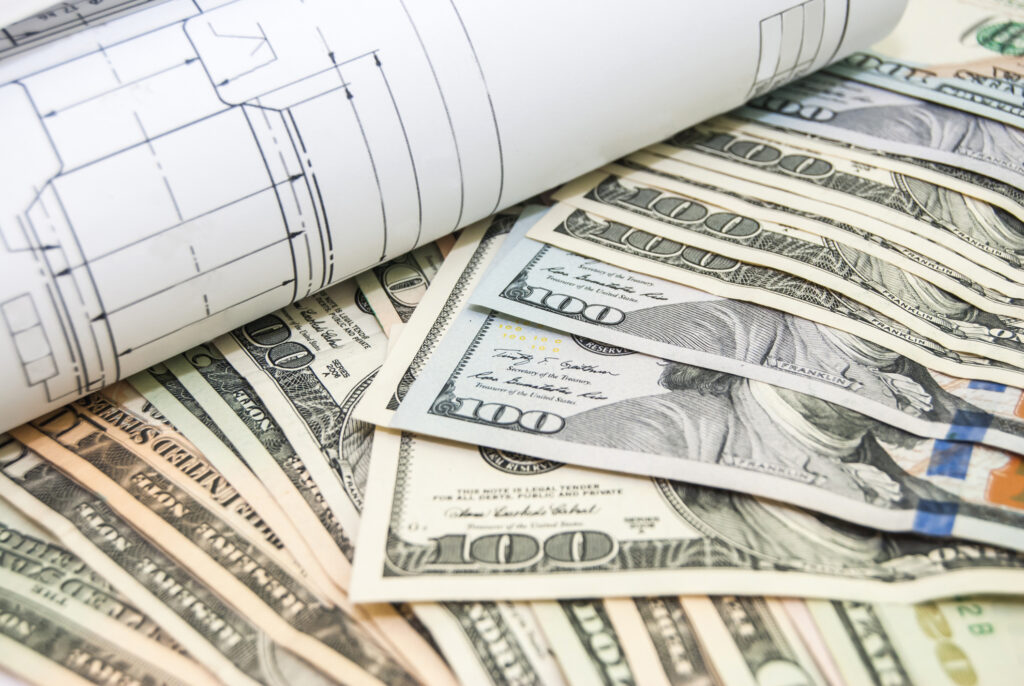Decarbonization Strategies: Step-by-Step Planning Fueled with Energy Optimization Savings

Key Highlights
- The decarbonization process can be rolled out in manageable phases, starting with baseline assessments, realistic goal-setting, and targeted improvements, which makes it possible to reduce emissions without disrupting operations or derailing capital plans.
- Energy optimization delivers fast, measurable emissions reductions at a low cost. These operational improvements not only cut energy use but also free up savings that can be reinvested to fund larger decarbonization projects.
- As performance standards like BERDO, BEUDO, and LL97 take hold across the U.S., organizations that move now to benchmark emissions and develop a roadmap will be better prepared to comply, avoid costly fines, and demonstrate sustainability leadership.
Climate change is no longer a distant threat — it’s a daily reality. As extreme heat, poor air quality, and natural disasters become more frequent, the call for action from high-emissions sectors is growing louder.
In the United States, buildings are responsible for nearly 30 percent of total greenhouse gas emissions, primarily from the use of fossil fuels for heating, cooling, and electricity. Institutions such as hospitals, universities, and research facilities, many of which operate large, energy-intensive campuses, face mounting pressure from regulators, investors, and the public to address their carbon footprints. But for many building owners and operators, getting started can feel overwhelming. Complex infrastructure, legacy systems, tight budgets, and the need to maintain uninterrupted operations all present significant hurdles.
Still, the path to decarbonization doesn’t have to be paralyzing. With the right planning, significant emissions reductions are possible, without blowing up budgets or compromising performance. A phased and strategic approach allows organizations to align decarbonization with capital planning, asset renewal, and operational priorities. In fact, many facilities can achieve substantial gains by first focusing on energy optimization, such as improving controls, upgrading equipment, or identifying waste, before making deeper structural changes like fuel switching or full electrification.
What’s often missing is a clear roadmap, one that is grounded in real data, financial insight, and operational feasibility. Every building is different, and there’s no one-size-fits-all solution to decarbonization. That’s why successful strategies start with a deep understanding of a facility’s energy use, system dependencies, and emissions profile. Armed with that knowledge, organizations can prioritize cost-effective actions and build momentum over time, meeting regulations while creating healthier, more resilient buildings.
Regulations Are Getting Real—and Local
Across the U.S., state and city governments are rolling out ambitious Building Performance Standards (BPS) aimed at achieving net-zero emissions, and the regulatory landscape is getting tougher by the year. Massachusetts is leading the charge, with Boston and Cambridge adopting two of the most stringent laws in the country: BERDO 2.0 and BEUDO. These regulations stand out for their mandatory emissions caps, aggressive deadlines (ranging from 2035 to 2050), broad applicability across building types (including residential), and clearly defined financial penalties for noncompliance.
Other major cities are following suit. New York City’s Local Law 97 (LL97) imposes steep early penalties for buildings that exceed emissions thresholds, while Washington, D.C.’s Building Energy Performance Standards (BEPS) apply to an even broader range of properties, including smaller buildings often overlooked by similar regulations. The message is clear: delay is no longer a viable strategy. Massachusetts, in particular, is setting the pace, especially for large, complex buildings in sectors like healthcare, higher education, and life sciences.
Taken together, these performance standards are redefining the expectations for energy and emissions compliance. Organizations that take a proactive approach, by benchmarking their current performance, setting realistic goals, and identifying both immediate and long-term opportunities, will be far better positioned to navigate this shifting regulatory landscape.
Barriers to Decarbonization
While the push toward net-zero emissions gains momentum, building owners and operators face a series of entrenched challenges that make decarbonization easier said than done. One of the most significant hurdles is the high-upfront cost associated with retrofitting aging systems or integrating new low-carbon technologies. The initial capital outlay can be a major deterrent, especially for organizations already managing tight operating budgets.
Aging infrastructure presents another formidable obstacle. Many buildings, particularly in sectors like healthcare, research, and higher education, were designed decades ago with fossil fuel-based systems like steam heating or gas-fired boilers. Retrofitting these legacy systems to support electrification or renewable energy can require extensive (and expensive) overhauls. In some cases, the buildings themselves simply weren’t designed with today’s sustainability goals in mind, making it difficult to integrate modern HVAC controls, renewable power sources, or energy-storage solutions without major structural work.
Compounding these technical challenges is the reality that many buildings operate 24/7 and cannot afford prolonged disruptions. Hospitals, laboratories, and data centers require uninterrupted operations to maintain safety, compliance, or critical business functions. This limits when and how upgrades can be performed, often requiring careful phasing, off-hour work, or temporary system redundancy, all of which add complexity and cost to implementation.
Capital planning cycles also play a key role. Large institutions typically plan budgets and capital investments several years in advance. Decarbonization efforts must compete with other high-priority projects for limited funding, and it can be difficult to align energy-focused upgrades with existing budgeting timelines. Many organizations still are navigating the nuances of new regulations, incentives, and technologies, making it harder to justify immediate investment without a clear roadmap or return on investment (ROI).
Finally, there’s the challenge of limited internal expertise. Many facility teams are already stretched thin, managing day-to-day operations and compliance requirements. The added complexity of decarbonization, ranging from emissions benchmarking and lifecycle cost modeling to technology evaluation and incentive navigation, often requires expertise and resources beyond what’s available in-house. Without the right support, teams may face missteps, delays, or missed opportunities that can impact long-term goals.
Phased Plans, Building Toward Net Zero
Despite the barriers, decarbonization is not out of reach. EH&E is helping clients with developing a strategic, phased approach, one that starts with low-risk, high-impact opportunities and builds a foundation for deeper emissions cuts over time. It involves identifying the key components of a phased decarbonization strategy tailored to the organization’s operational and financial constraints.
Real-world constraints such as aging infrastructure and legacy systems are incorporated into a realistic, phased decarbonization planning process. Energy optimization is leveraged to deliver immediate emissions reductions, realize cost savings, and fund deeper decarbonization efforts over time. Organizations come away with a clear understanding of how to break down the decarbonization process into manageable phases, how to work within the constraints of aging systems, and how to begin applying this framework to their own facilities.
EH&E’s phased approach is broken down into the following steps:
Step 1: Baseline Assessment
The journey begins with understanding how a facility uses energy and where its emissions originate. This includes analyzing utility data, evaluating building system performance, and identifying fuel sources that support critical operations. Factors such as reliance on steam, aging equipment, and backup power requirements are integrated into a comprehensive emissions profile that guides the path forward.
Step 2: Goal Setting
Next, facilities define emissions-reduction targets that are both ambitious and achievable. These goals are tied to broader organizational priorities, such as patient safety, operational reliability, and long-term cost control, to ensure that decarbonization efforts support, rather than disrupt, core operations.
Step 3: Opportunity Identification
With a solid baseline and clear goals, facilities can identify and evaluate decarbonization strategies. These range from low-cost improvements, like optimizing building controls and equipment schedules, to larger investments such as heat pump integration or full-system electrification. Each option is assessed based on emissions impact, implementation complexity, cost, and available incentives, enabling informed, data-driven decision-making.
Step 4: Roadmap Development
The final step is developing a phased roadmap that sequences these actions over time. The roadmap is aligned with capital planning cycles and designed for flexibility, so it can evolve with facility needs, technology advancements, and regulatory changes.
Smarter Way to Start: Energy Optimization
Energy optimization is the lowest-cost, highest impact first step towards decarbonization. It can reduce emissions by five to ten percent immediately through operational strategies such as equipment scheduling, airflow balancing, and control tuning. In large facilities, these improvements can result in substantial utility savings, sometimes exceeding $1 million over just a few years, which can be reinvested to support deeper decarbonization efforts.
By targeting low-cost, high-impact improvements in how existing systems are operated, organizations can unlock immediate utility savings and free up capital. Dollars saved via energy optimization can be redirected toward higher cost decarbonization efforts, such as upgrading heat pumps, replacing steam systems, integrating on-site renewables and investing in advanced building management systems.
For example, an EH&E client, focused on complying with local emissions regulations under BERDO, used this framework to guide its decarbonization strategy. By prioritizing energy optimization as a first step in their roadmap, they are projected to save $400,000 to $450,000 per year in avoided fines and energy savings by 2035. Examples like this demonstrate how early targeted actions can generate immediate results, reduce risk, and build momentum for deeper change.
In short, energy optimization is a low-risk, high-reward starting point for decarbonization. It creates the financial and operational headroom organizations need to tackle more complex upgrades, turning short-term savings into long-term sustainability.

Inaction is Not an Option
In the face of growing climate risks and evolving regulatory pressure, inaction is no longer a viable option, but neither is rushing forward without a plan. The opportunity lies in a smart, phased decarbonization strategy, one that balances ambition with practicality and operational resilience. Beyond compliance, early action also offers a chance to demonstrate sustainability leadership, unlock operational savings, and future-proof their organizations against rising regulatory and reputational risk.
Ready to start your decarbonization journey? Contact EH&E today.
Subscribe
to our blog
"*" indicates required fields




